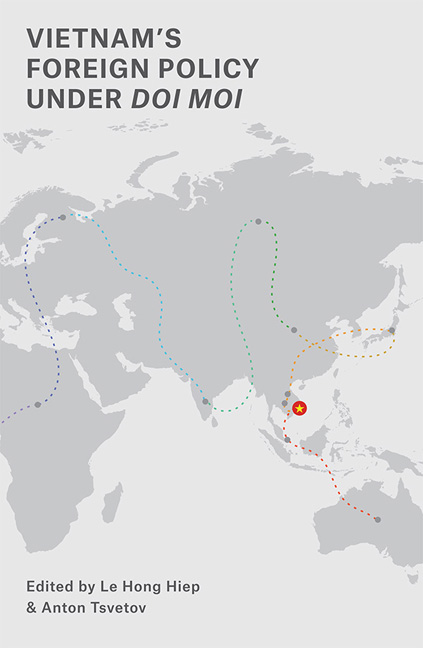Book contents
- Frontmatter
- Contents
- List of Tables
- List of Figures
- List of Abbreviations
- Acknowledgements
- About the Contributors
- PART I ANALYTICAL AND HISTORICAL FRAMEWORK
- PART II BILATERAL RELATIONSHIPS
- PART III MAJOR FOREIGN POLICY ISSUES
- 10 Vietnam's South China Sea Strategy since 2007
- 11 Vietnam's International Economic Integration under Doi Moi
- 12 Norm Diffusion through Trade: The Case of the EU–Vietnam Free Trade Agreement
- Index
10 - Vietnam's South China Sea Strategy since 2007
from PART III - MAJOR FOREIGN POLICY ISSUES
Published online by Cambridge University Press: 04 July 2018
- Frontmatter
- Contents
- List of Tables
- List of Figures
- List of Abbreviations
- Acknowledgements
- About the Contributors
- PART I ANALYTICAL AND HISTORICAL FRAMEWORK
- PART II BILATERAL RELATIONSHIPS
- PART III MAJOR FOREIGN POLICY ISSUES
- 10 Vietnam's South China Sea Strategy since 2007
- 11 Vietnam's International Economic Integration under Doi Moi
- 12 Norm Diffusion through Trade: The Case of the EU–Vietnam Free Trade Agreement
- Index
Summary
Over the past decade, territorial and maritime disputes in the South China Sea have become an issue of greater global significance. The disputes, which traditionally involve competing sovereignty and jurisdiction claims by littoral states, have now also encompassed aspects of the intensifying strategic competition between the major powers, especially China, the United States, and Japan. At the same time, the increasing militarization of the disputes by different parties also poses a serious risk to global peace and trading activities.
As one of the key claimant states, Vietnam has since 2007 experienced a new wave of tensions in the South China Sea, with China being the main security challenger. On the economic front, Beijing steps up its patrols in the South China Sea and tries to drive Vietnamese fishermen away from their traditional fishing grounds in the Paracels and the Spratlys. Incidents in which Chinese law enforcement vessels chase, capture, confiscate, or attack Vietnamese fishing boats are frequently reported in the Vietnamese media. Every year, dozens of Vietnamese fishermen are reportedly captured, beaten, or killed by Chinese law enforcement authorities (Tuan 2012). China also puts pressure on international oil companies that operate inside Vietnam's proclaimed exclusive economic zone (EEZ). More importantly, China has since 2014 reclaimed land and built seven artificial islands in the Spratlys. By the end of 2015, China had reclaimed seventeen times more land than the other claimants combined over the preceding forty years, accounting for about 95 per cent of all reclaimed land in the Spratlys (U.S. Department of Defence 2015, p. 16). China has also installed dual-purpose equipment, including helipads, airstrips, and surveillance radars, on its artificial islands.
Against this backdrop, how to manage the disputes in order to protect its legitimate interests against rising threats while preserving peace and stability in the South China Sea has long been a major foreign policy challenge for Vietnam. This chapter examines this challenge and how Vietnam has handled it since 2007 when tensions in the South China Sea began to intensify. The chapter argues that Hanoi considers the South China Sea disputes as a highly complicated security issue that warrants a multi-faceted approach.
- Type
- Chapter
- Information
- Vietnam's Foreign Policy under Doi Moi , pp. 211 - 234Publisher: ISEAS–Yusof Ishak InstitutePrint publication year: 2018

